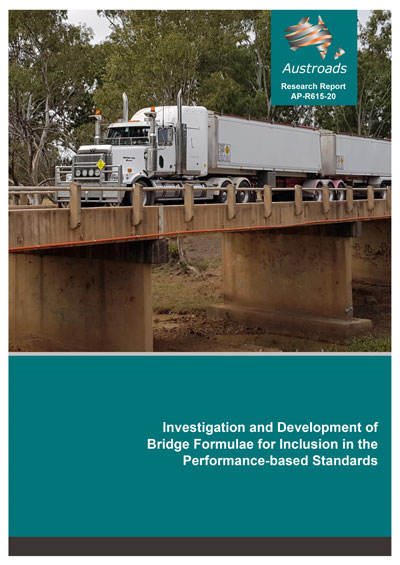Freight

- Publication no: AP-R615-20
- ISBN: 978-1-925854-93-0
- Published: 13 March 2020
- PDF (free) Download
The May 2018 National Transport Commission review of the Australian Performance-Based Standards (PBS) scheme revealed the need to improve the efficiency of heavy vehicle access via the PBS scheme to access substantial national freight productivity, safety and environmental outcomes. The review has found three key elements that are needed to improve the take-up and effectiveness of the scheme. These include providing more certain access, faster access decisions and developing nationally consistent guidelines for bridge assessment. This project is the first step in addressing the proposed reforms and has focused on reviewing the current PBS Tier 1 bridge formulae and identifying issues through analytical review of possible PBS vehicle load effects that can be achieved and through consultation with various road agencies. A review of current infrastructure assessment practices has also been undertaken as part of the project. Three options for future bridge assessment in Australia are presented and discussed in relation to the key Ministerial objectives for the future of PBS access assessment. Gazettal of routes to the current bridge formulae was not supported by the project reference group.
The project reference group resolved to recommend that a line model comparison methodology be implemented to drive a nationally consistent vehicle assessment framework.
Gazettal of routes to the current bridge formulae was not initially supported by several members of the project reference group. As a compromise a number of state road agencies have agreed to gazette routes for key PBS configurations in the interim, while the line model comparison framework is fully tested and implemented.
- Summary
- 1. Introduction
- 1.1 Background
- 1.2 Aims and Objectives
- 1.3 Scope
- 2. Literature Review of the Current Australian Bridge Formulae
- 2.1 Origins of the Current Australian Bridge Formulae
- 3. Analytical Review of the Current Formulae
- 3.1 Introduction
- 3.2 Stakeholder Feedback on Issues Associated with the Current Bridge Formulae
- 3.3 Setting the Design Load Comparison Level
- 3.3.1 Preparation of PBS Vehicles
- 3.3.2 Critical Vehicle Configurations
- 3.4 Analysis Methodology and Assumptions
- 3.4.1 Load Effect vs Span Relationships Using a Line Model
- 3.5 Summary of Analytical Findings
- 3.6 Factors to Consider before Changing the Current Formulae
- 3.7 Recommendations Related to the Current Bridge Formulae
- 4. Options for the Future of Bridge Access Assessment in Australia
- 4.1 Context
- 4.2 Option 1: Leave PBS Formulas Unchanged and Declare Networks
- 4.2.1 Description
- 4.2.2 Will it Meet the Ministerial Objectives?
- 4.2.3 Risks to Ministerial Timeframes
- 4.2.4 Jurisdictional Issues
- 4.2.5 Other Critical Issues
- 4.2.6 Implementation Considerations
- 4.3 Option 2: Adopt Additional High Load Service Levels above the Current Bridge Formulae
- 4.3.1 Description
- 4.3.2 Will it Meet the Ministerial Objectives?
- 4.3.3 Risks to Ministerial Timeframes
- 4.3.4 Jurisdictional Issues
- 4.3.5 Other Critical Issues
- 4.3.6 Implementation Considerations
- 4.4 Option 3: Automated Tier 2 Approach for Higher Loads
- 4.4.1 Description
- 4.4.2 Will it Meet the Ministerial Objectives?
- 4.4.3 Risks to Ministerial Timeframes
- 4.4.4 Jurisdictional Issues
- 4.4.5 Other Critical Issues
- 4.4.6 Implementation Considerations
- 4.5 Development of a Nationally Harmonised Infrastructure Capability Assessment Framework
- 4.5.1 Current Status of Assessment in Australia
- 4.5.2 Costs Associated with Harmonisation
- 4.5.3 Risks Associated with Harmonisation
- 4.5.4 Recommendations for a Nationally Harmonised Infrastructure Capability Assessment Framework
- 4.5.5 Local Government Considerations
- 5. Development of a Framework for Bridge Capability Assessment and Asset Optimisation
- 6. Considerations by the Project Reference Group
- 6.1 Gazetting Routes Using the Current Bridge Formulae
- 6.2 Recommendations of the Project Reference Group
- 6.3 Gazetting Routes as an Interim Measure
- 6.4 Implementation of the Line Model Comparison Framework
- 7. Conclusions
- 7.1 Summary
- 7.2 Consultation and Recommendations of the Project Reference Group
- References
- Appendix A Analytical Review of the Current Formulae
- A.1 Normalised Load Effects
- A.2 Setting the Design Load Comparison Level
- A.3 Critical Vehicle Configurations
- A.4 Results
- A.4.1 Simple Support Moment
- A.4.2 Simple Support Shear
- A.4.3 Simple Support Pier Reaction
- A.4.4 Continuous Support Moment
- A.4.5 Continuous Support Shear
- A.4.6 Continuous Support Pier Reaction
- A.5 Discussion about the Caveats left out of the 2007 PBS Legislation
- Appendix B Development of New Bridge Formulae Defining Higher Service Levels
- B.1 Method for Developing the Formulae
- B.2 Results
- B.2.1 Simply Supported Spans
- B.2.2 Continuous spans
- Appendix C Options for the Future of Bridge Access Assessment in Australia
